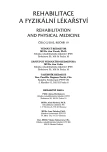-
Medical journals
- Career
Early Results Following Rehabilitation of Conservatively Treated Distal Radius Fractures
Authors: Z. Jožefiová 1; R. Morochovič 2; P. Takáč 1; R. Burda 2
Authors‘ workplace: Klinika fyziatrie, balneológie a liečebnej rehabilitácie LF UPJŠ a UNLP Košice, prednosta doc. MUDr. P. Takáč, Ph. D. 1; Klinika úrazovej chirurgie LF UPJŠ a UNLP Košice, prednosta prof. MUDr. M. Kitka, Ph. D. 2
Published in: Rehabil. fyz. Lék., 19, 2012, No. 2, pp. 80-84.
Category: Original Papers
Overview
Background:
Distal radius fractures are among the most common skeletal injuries in human population. They mostly occur in patients of middle and old age, due to frequent falling and poor bone quality. With increasing number of elderly people who have sustained distal radius fracture it is necessary to pay attention to the treatment and rehabilitation of these patients.Objective:
To evaluate the effect of 4 - week comprehensive rehabilitation treatment and the influence of comorbidities to renew the functional status, and psychological and social comfort in patients following conservative treatment of distal radius fracture.Methods:
Thirty one patients were included in the study whose distal radius fracture was treated by closed reduction followed by immobilization in a cast and rehabilitation in Department of Physiatry, Balneology and Rehabilitation Medicine in L. Pasteur University Hospital in Košice from April 2010 to January 2011. The range of carpal joint motion and muscle functioning was measured at the beginning and after 4 weeks of rehabilitation therapy. Perception of subjective problems and recovery of functional abilities were evaluated using questionnaire PRWE (The Patient - Rated Wrist Evaluation). Relationship between the final score and associated comorbidities were determined.Results:
The range of carpal joint motion was significantly improved from 239.8 (SD 31.6) to 312.2 (SD 35.2) (t test p<0.01) as well as the hand muscle function which increased from mean 2.97 (SD 0.48) to 3.80 (SD 0.54), (Mann Whitney, p<0.01). For PRWE questionnaire the average initial score was 50.9 (SD 13.3) and average final score was 27.3 (SD 11.7). Noticed improvements after rehabilitation were statistically significant measured by questionnaire (t test, p <0.01). The subjective improvement was lower in the subgroup of patients with comorbidities and those ones who did not regain grip strength.Conclusion:
It is possible to achieve objective and subjective improvements in wrist and hand function by early and intensive rehabilitation following conservative treatment of distal radius fracture. Subjective perception of improvement after rehabilitation is probably modified by influence of chronic comorbidities.Key words:
distal radius fractures, rehabilitation treatment, comorbidities, PRWE questionnaire
Sources
1. FOUSEK, J., CYPRICH, J.: Zlomeniny distálního konce radia. Acta Chir. Orthop. Traumatol. Cech., 62, 1995, 4, s. 244-247.
2. JANDA, V.: Svalové funkční testy. 1. vyd., Praha, Grada, 2004, s. 328, ISBN: 8024707225.
3. KARNEZIS, I. A., FRAGKIADAKIS, E. G.: Association between objective clinical variables and patient - rated disability of the wrist. J. Bone Joint Surg. Br., 84, 2002, 7, s. 967-970.
4. KARNEZIS, I. A., PANAGIOTOPOULOS, E., TYLLIANAKIS, M., MEGAS, P., LAMBIRIS, E.: Correlation between radiological parameters and patient - rated wrist dysfunction following fractures of the distal radius. Injury, 36, 2005, 12,s. 1435-1439.
5. KOLÁŘ, P.: Rehabilitace v klinické praxi. 1. vyd., Praha, Galén, 2009, s. 713, ISBN: 9788072626571.
6. KRÍŽ, V.: Rehabilitace a její uplatnení po úrazech a operacích. 1. vyd., Praha, Avicenum, 1986, s. 330.
7. MACDERMID, J. C.: The patient - rated wrist evaluation (PRWE) © User Manual, 2007 [citované 2010-03-10]. Dostupné na internete: http://www.srs-mcmaster.ca/Portals/20/pdf/research_resources/PRWE_PRWHEUserManual_Dec2007.pdf.
8. MACDERMID, J. C., ROTH, J. H., RICHARDS, R. S.: Pain and disability reported in the year following a distal radius fracture: a cohort study. BMC Musculoskelet Disord., 24, 2003, 4.
9. MACDERMID, J. C., TURGEON, T., RICHARDS, R. S., BEADLE, M., ROTH, J. H.: Patient rating of wrist pain and disability: a reliable and valid measurement tool. J. Orthop. Trauma, 12, 1998, 8, s. 577-586.
10. MARSH, J. L., SLONGO, T. F., AGEL, J., BRODERICK, J. S., CREEVEY, W., DECOSTER, T. A., PROKUSKI, L., SIRKIN, M. S., ZIRAN, B., HENLEY, B., AUDIGE, L.: Fracture and dislocation classification compendium - 2007: Orthopaedic Trauma Association classification, database and outcomes committee. J. Orthop. Trauma, 21, 2007, 10, Suppl., s. S1-S133.
11. PACOVSKÝ, V.: Zlomeniny distálního radia. 1. část: Statistické zhodnocení souboru. Acta Chir. Orthop. Traumatol. Cech., 70, 2003, 2, s. 108-111.
12. RUBER, V., IRA, D., KOVAŘÍK, J.: Zlomeniny distálního radia. Úrazová chirurgie, 17, 2009, 4, s. 114-117.
13. TOMČOVČÍK, Ľ., KUBAŠOVSKÝ, J.: Perkutánna osteosyntéza zlomenín distálneho radia a hodnotenie výsledkov. Acta Chir. Orthop. Traumatol. Cech., 66, 1999, 4, s. 243-247.
14. VAJCZIKOVÁ, S., LÁTAL, J., LOHNERT, J., BRAUNSTEINER, T., ŠIMKO, P.: Fractura loco typico - terapeutický problém. Lek. Obzor, 47, 1998, 5, s. 155-157.
Labels
Physiotherapist, university degree Rehabilitation Sports medicine
Article was published inRehabilitation & Physical Medicine

2012 Issue 2-
All articles in this issue
- Mechanical Diagnostics and Therapy – Advantage of the Treatment According to McKenzie
- The TEST According to Véle or the VÉLE-TEST
- Hippotherapy as a Supplementary Method in Physiotherapy: Review of Available Literature
- Early Results Following Rehabilitation of Conservatively Treated Distal Radius Fractures
- Electromyographyc Analysis of the Traditional and Alternative Hoalding of White Cane
- Activation of the Deep Stabilization System and Training in Stabilization of the Extremity Joints with the Flexi-bar®
- Riding a Bicycle and Patellofemoral Compartment Syndrome
- Rehabilitation & Physical Medicine
- Journal archive
- Current issue
- Online only
- About the journal
Most read in this issue- The TEST According to Véle or the VÉLE-TEST
- Riding a Bicycle and Patellofemoral Compartment Syndrome
- Mechanical Diagnostics and Therapy – Advantage of the Treatment According to McKenzie
- Early Results Following Rehabilitation of Conservatively Treated Distal Radius Fractures
Login#ADS_BOTTOM_SCRIPTS#Forgotten passwordEnter the email address that you registered with. We will send you instructions on how to set a new password.
- Career

